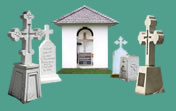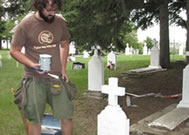St. Elijah Bucovinian Pioneer Cemetery
- Take a visit in photos

- Tour photo link
- Tour photo link
- Tour photo link
- Tour photo link
- Tour photo link
- Tour photo link
- Tour photo link
- Tour photo link
- Tour photo link
- Tour photo link
- Tour photo link
- Tour photo link
- Tour photo link
- Tour photo link
- Tour photo link
- Tour photo link
- Tour photo link
- Tour photo link
- Tour photo link
- Tour photo link
- Tour photo link
- Tour photo link
- Tour photo link
- Tour photo link
- Tour photo link
- Tour photo link
- Tour photo link
- Tour photo link
- Tour photo link
- Tour photo link
- Tour photo link
- Tour photo link
- Tour photo link
- Tour photo link
- Tour photo link
- Tour photo link
- Tour photo link
- Tour photo link
Restoring and Preserving
Bucovinian Pioneers’ Memorials
No church, no cemetery
When the Romanian and Ukrainian settlers arrived in the Asessippi district in 1900, they had no church and no cemetery. If someone in the community died, they were buried in the Rochedale or Asessippi cemeteries. One of the first of these was Angelina Burla, daughter if Elie and Dominica Burla, who died in 1901. She was buried in the Rochedale Cemetery, across the Shell River valley.
First burials in the cemetery: piecing it together
This event spurred the new arrivals to think about finding a suitable place to worship and to bury their dead. Later that year they erected a rustic wooden cross on the homestead of Elie Burla around which they conducted simple worship services. Nearby, an area was set aside for a cemetery.
Because official church records no longer exist, it is not known who was the first person to be buried in the new cemetery. One pioneer, Nistor Onofrecuic, recorded that Plasiu Hackman, son of Petru Hackman, lay priest from 1903 to 1907, was the first to be buried there in 1904. Plasiu was killed in a farm accident. The grave marker no longer exists. The second was Grigori Gabor, who was also killed in an accident in 1905 and is buried in a marked grave. However, another pioneer, Agrapina Gabor, related that the first burial was a 12-year old Kobluk boy, and the second was 2-year old Gheorghe Burla. She also recalled that there may have been two other individuals buried at about the same time - Mrs. Vasile Lungul and Toderi Chieper. There are no official church records to verify any of these events.
Markers and records burnt
In the early days of the community, many grave markers were simple wooden crosses, usually made from tamarack timbers. Eventually, most of these crosses decayed and fell. In 1950, a grass fire swept through the cemetery and destroyed most of the downed crosses. Only those markers constructed of stone or concrete survived. Since the church records were also lost in another fire that destroyed the manse in 1939, there are no records available to determine when and where anyone was buried in the old cemetery.
It is estimated that there are between 70 and 100 unmarked graves in the old section of the cemetery. Many of these graves were placed an a haphazard manner, as it was difficult to follow laid-out rows in those days, especially in the winter when the ground was frozen and covered with deep snow.
Restoration of the cemetery
Starting in the 1980s, a determined effort was made to restore the pioneer cemetery . Many volunteers spent much time, effort and money to turn the site into the pristine condition in which it is today. Some of the remaining grave markers were moved slightly to establish orderly rows and facilitate maintenance and grooming. Simple iron crosses were installed to indicate where the unmarked graves may be located. A common memorial to honour these pioneers was erected in 2003 on the occasion of the 100th anniversary of the parish. A plain wooden cross and a bronze plaque were installed inside a small structure resembling a prayer station common to villages in the Carpathian Mountain region of old Bucovina. This cairn is a memorial to the pioneers and their children who are buried there. Only one name is listed on the plaque; that of Petru Hackman, the first lay priest of the parish who is buried in an unmarked grave in the cemetery.
Find out more: take a visit in photos
Contribute: If you have any further information or historic documents related to the St. Elijah Pioneer Cemetery we would be more than happy to find out more. Please go to our Contribute page or write us at .

